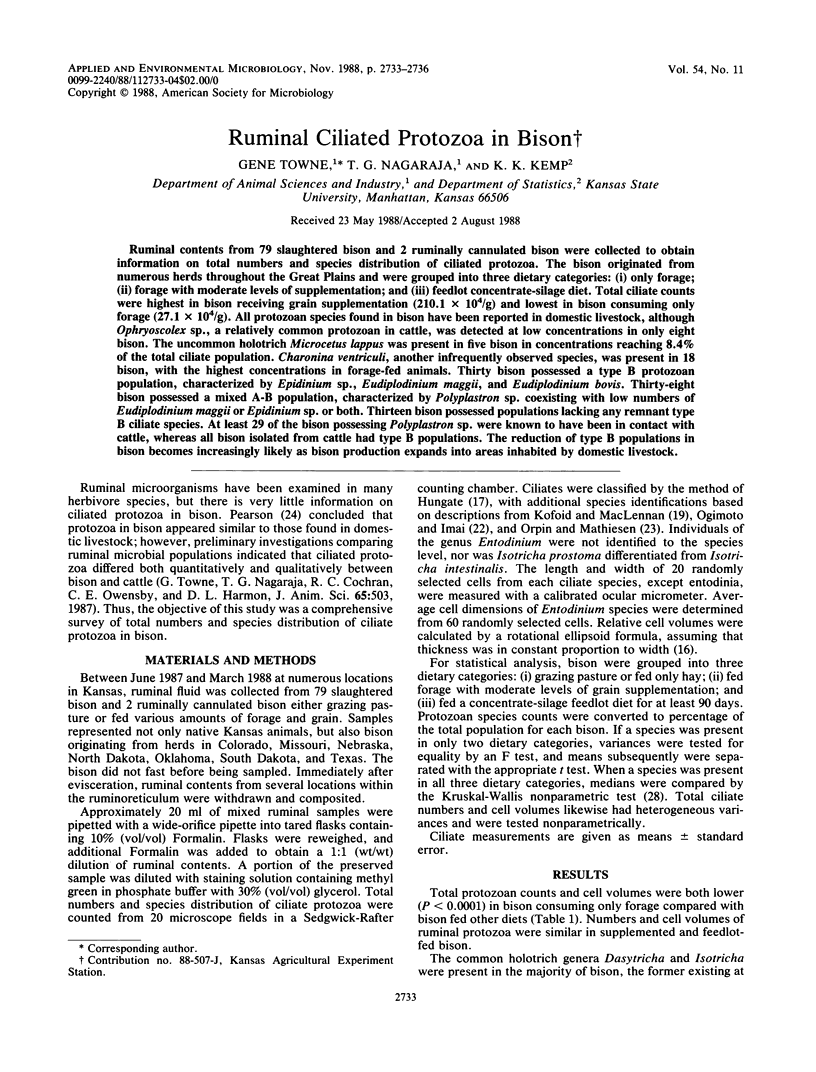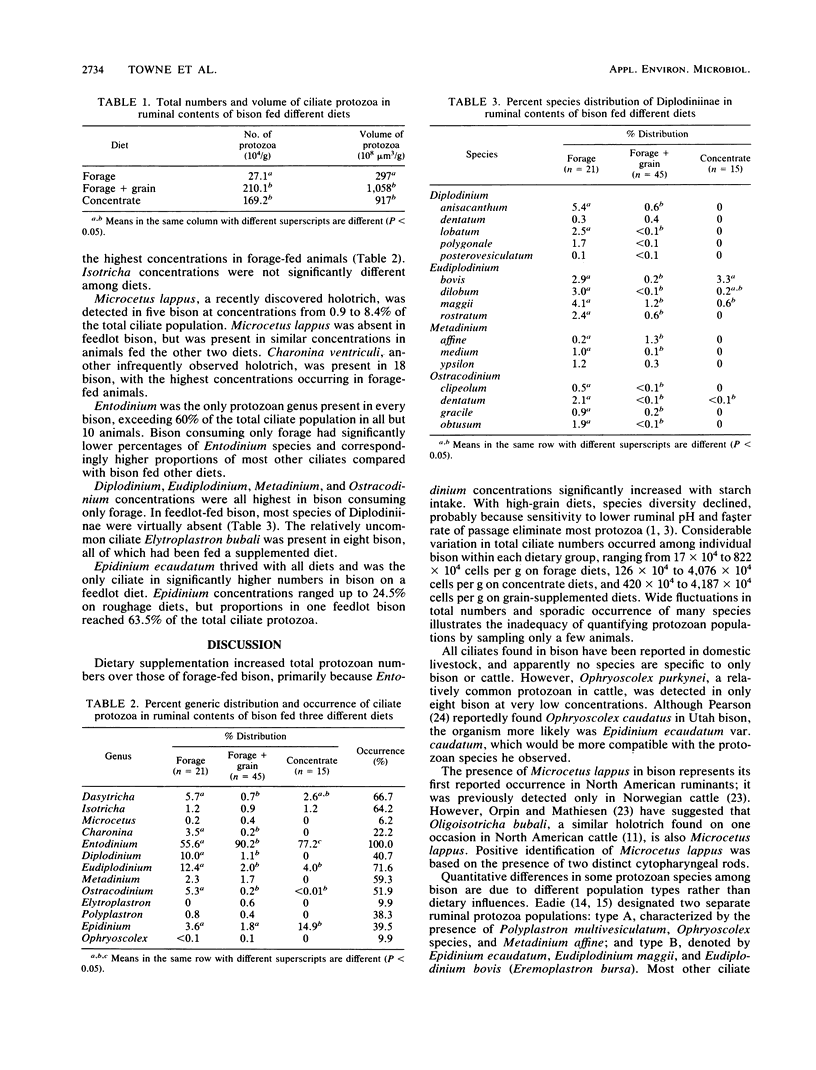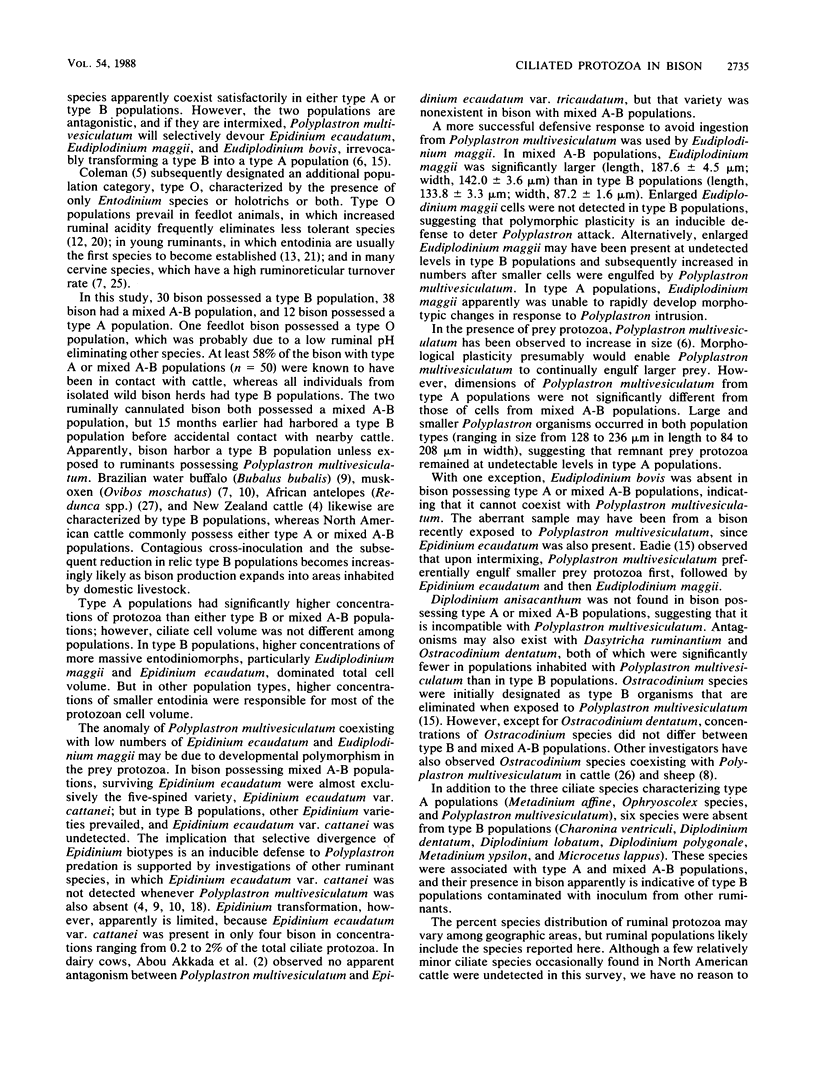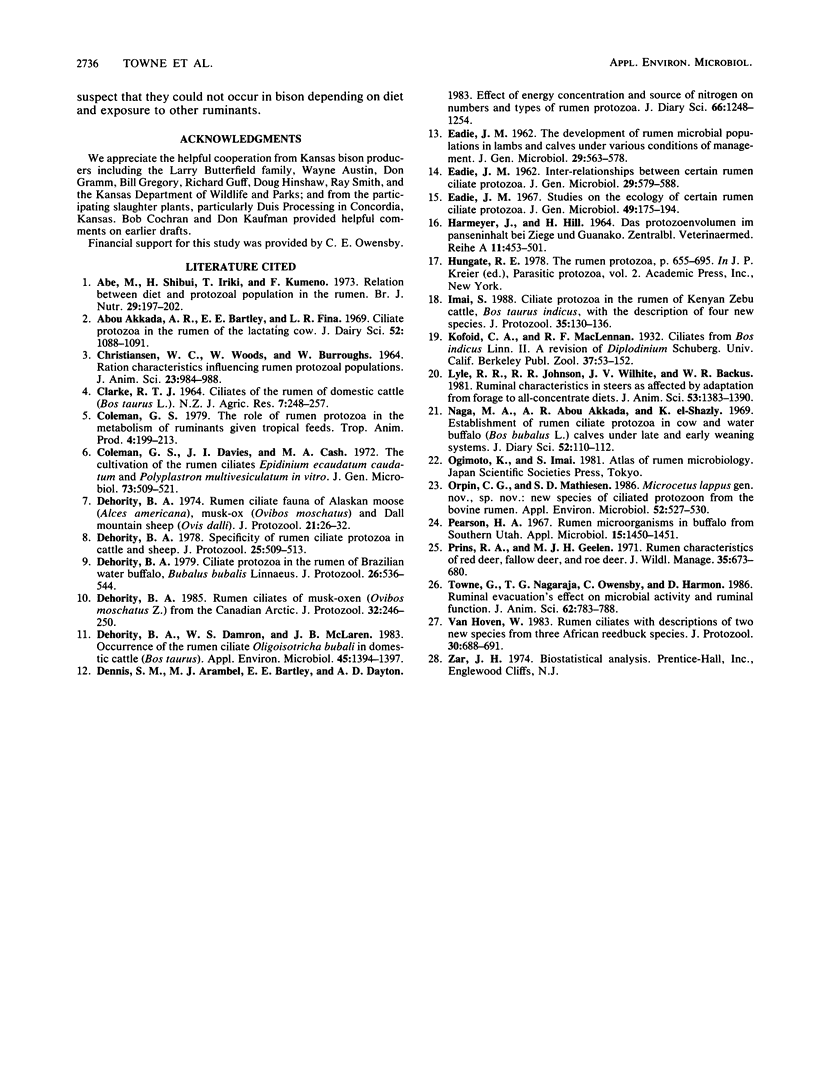Abstract
Ruminal contents from 79 slaughtered bison and 2 ruminally cannulated bison were collected to obtain information on total numbers and species distribution of ciliated protozoa. The bison originated from numerous herds throughout the Great Plains and were grouped into three dietary categories: (i) only forage; (ii) forage with moderate levels of supplementation; and (iii) feedlot concentrate-silage diet. Total ciliate counts were highest in bison receiving grain supplementation (210.1 x 10(4)/g) and lowest in bison consuming only forage (27.1 x 10(4)/g). All protozoan species found in bison have been reported in domestic livestock, although Ophryoscolex sp., a relatively common protozoan in cattle, was detected at low concentrations in only eight bison. The uncommon holotrich Microcetus lappus was present in five bison in concentrations reaching 8.4% of the total ciliate population. Charonina ventriculi, another infrequently observed species, was present in 18 bison, with the highest concentrations in forage-fed animals. Thirty bison possessed a type B protozoan population, characterized by Epidinium sp., Eudiplodinium maggii, and Eudiplodinium bovis. Thirty-eight bison possessed a mixed A-B population, characterized by Polyplastron sp. coexisting with low numbers of Eudiplodinium maggii or Epidinium sp. or both. Thirteen bison possessed populations lacking any remnant type B ciliate species. At least 29 of the bison possessing Polyplastron sp. were known to have been in contact with cattle, whereas all bison isolated from cattle had type B populations. The reduction of type B populations in bison becomes increasingly likely as bison production expands into areas inhabited by domestic livestock.
Full text
PDF



Selected References
These references are in PubMed. This may not be the complete list of references from this article.
- Abe M., Shibui H., Iriki T., Kumeno F. Relation between diet and protozoal population in the rumen. Br J Nutr. 1973 Mar;29(2):197–202. doi: 10.1079/bjn19730094. [DOI] [PubMed] [Google Scholar]
- Abou Akkada A. R., Bartley E. E., Fina L. R. Ciliate protozoa in the rumen of the lactating cow. J Dairy Sci. 1969 Jul;52(7):1088–1091. doi: 10.3168/jds.S0022-0302(69)86697-X. [DOI] [PubMed] [Google Scholar]
- Coleman G. S., Davies J. I., Cash M. A. The cultivation of the rumen ciliates Epidinium ecaudatum caudatum and Polyplastron multivesiculatum in vitro. J Gen Microbiol. 1972 Dec;73(3):509–521. doi: 10.1099/00221287-73-3-509. [DOI] [PubMed] [Google Scholar]
- Dehority B. A. Ciliate protozoa in the rumen of Brazilian water buffalo, Bubalus bubalis Linnaeus. J Protozool. 1979 Nov;26(4):536–544. doi: 10.1111/j.1550-7408.1979.tb04191.x. [DOI] [PubMed] [Google Scholar]
- Dehority B. A., Damron W. S., McLaren J. B. Occurrence of the Rumen Ciliate Oligoisotricha bubali in Domestic Cattle (Bos taurus). Appl Environ Microbiol. 1983 Apr;45(4):1394–1397. doi: 10.1128/aem.45.4.1394-1397.1983. [DOI] [PMC free article] [PubMed] [Google Scholar]
- Dehority B. A. Rumen ciliate fauna of Alaskan moose (Alces americana), musk-ox (Ovibos moschatus) and Dall moutain sheep (Ovis dalli). J Protozool. 1974 Feb;21(1):26–32. doi: 10.1111/j.1550-7408.1974.tb03612.x. [DOI] [PubMed] [Google Scholar]
- Dennis S. M., Arambel M. J., Bartley E. E., Dayton A. D. Effect of energy concentration and source of nitrogen on numbers and types of rumen protozoa. J Dairy Sci. 1983 Jun;66(6):1248–1254. doi: 10.3168/jds.S0022-0302(83)81931-6. [DOI] [PubMed] [Google Scholar]
- Eadie J. M. Studies on the ecology of certain rumen ciliate protozoa. J Gen Microbiol. 1967 Nov;49(2):175–194. doi: 10.1099/00221287-49-2-175. [DOI] [PubMed] [Google Scholar]
- Imai S. Ciliate protozoa in the rumen of Kenyan zebu cattle, Bos taurus indicus, with the description of four new species. J Protozool. 1988 Feb;35(1):130–136. doi: 10.1111/j.1550-7408.1988.tb04092.x. [DOI] [PubMed] [Google Scholar]
- Naga M. A., Abou Akkada A. R., el-Shazly K. Establishment of rumen ciliate protozoa in cow and water buffalo (Bosbubalus L.) calves under late and early weaning systems. J Dairy Sci. 1969 Jan;52(1):110–112. doi: 10.3168/jds.S0022-0302(69)86510-0. [DOI] [PubMed] [Google Scholar]
- Orpin C. G., Mathiesen S. D. Microcetus lappus gen. nov., sp. nov.: new species of ciliated protozoon from the bovine rumen. Appl Environ Microbiol. 1986 Sep;52(3):527–530. doi: 10.1128/aem.52.3.527-530.1986. [DOI] [PMC free article] [PubMed] [Google Scholar]
- Pearson H. A. Rumen microorganisms in buffalo from southern utah. Appl Microbiol. 1967 Nov;15(6):1450–1451. doi: 10.1128/am.15.6.1450-1451.1967. [DOI] [PMC free article] [PubMed] [Google Scholar]
- Towne G., Nagaraja T. G., Owensby C., Harmon D. Ruminal evacuation's effect on microbial activity and ruminal function. J Anim Sci. 1986 Mar;62(3):783–788. doi: 10.2527/jas1986.623783x. [DOI] [PubMed] [Google Scholar]


